Trying to decide between the 22 ARC vs 223 Remington cartridges for coyote and varmint hunting? Here’s what you need to know about them.
The 223 Remington is one of America’s most popular hunting cartridges for many reasons, but the fact that it functions so well in the AR-15 platform (America’s favorite gun) is a big part of the reason why that’s the case.
Additionally, the 223 Remington is also just a darn effective hunting cartridge, especially for coyotes and other predators and varmints. Even so, many hunters and shooters have long dreamed of a more powerful alternative to the 223 Remington that will still function well in an AR-15.
Hornady developed the new 22 Advanced Rifle Cartridge specifically for that crowd and their new round purports to deliver 22-250 level performance out of an AR.
That’s a bold claim, but is that actually the case? And if so, what soft of capability does the 22 ARC bring to the table that the 223 Remington lacks?
With those things in mind, I investigate the 22 ARC vs 223 Remington debate in detail in this article in order to provide some insight into which rifle cartridge is ideally suited for your specific hunting situation.
Table of Contents
History Of The 22 Advanced Rifle Cartridge & 223 Remington
We’ll start off with the 223 Remington.
Long story short, the US Military replaced the M-14 rifle and 7.62x51mm cartridge with the M-16 rifle and the high velocity 5.56x45mm cartridge in the early 1960s. They did this in an effort to provide Soldiers with a lighter rifle, with less recoil, with easier to control automatic fire capability, and to allow those Soldiers to carry a larger amount of ammunition for the same total weight as the larger 7.62x51mm cartridge.
Designers built this new cartridge, known initially as the 222 Special, by lengthening a 222 Remington case and moving the shoulder forward to increase powder capacity. This resulted in a cartridge powerful enough to meet the specified requirements of the military.
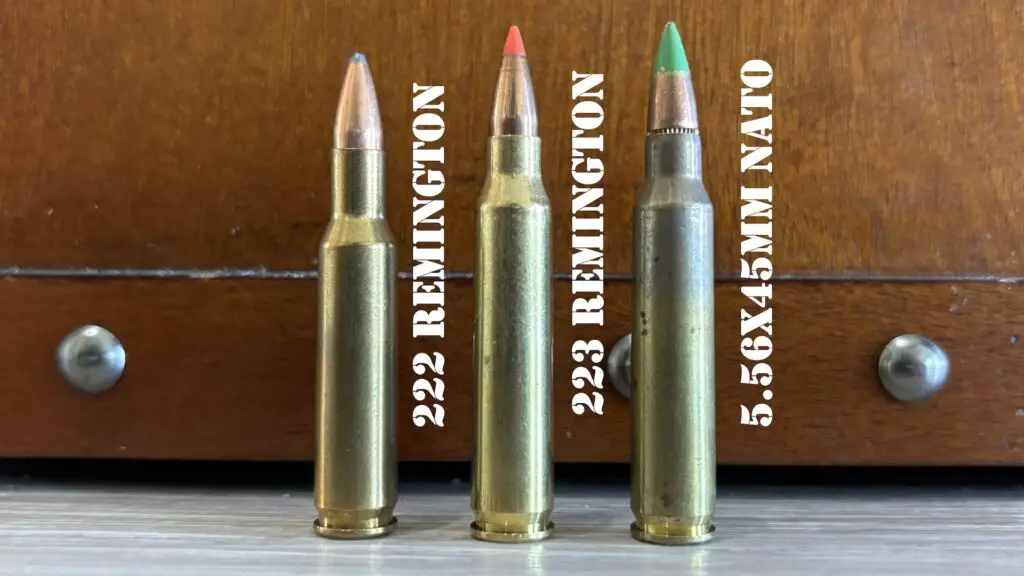
Though Remington has had uneven results with cartridges they’ve designed (like the 6.5mm Remington Magnum, 280 Remington, and 350 Remington Magnum), Big Green has done a much better job of standardizing and marketing rounds that came along via other avenues (like the 22-250, 25-06, and 7mm-08).
In this case, folks at Remington liked what they saw with the new 5.56x45mm NATO round and standardized a new cartridge (which is very similar, but not identical to the military round) with SAAMI as the .223 Remington in the early 1960s.
Factory loads for the new 223 Remington could push a 55-grain bullet at nearly 3,300fps (1,330 foot pounds of energy) and it quickly caught on with target shooters and varmint hunters.
Plus, this new cartridge was designed from the beginning to function in the then brand new M-16 rifle. Though both rifle and cartridge have experienced a number of ups and downs along the way, the civilian AR-15 platform is now the single most popular rifle model in the United States as I type this.
The same is true for the 223 Remington and the cartridge is more popular among recreational shooters and hunters in more recent years than ever was the case.
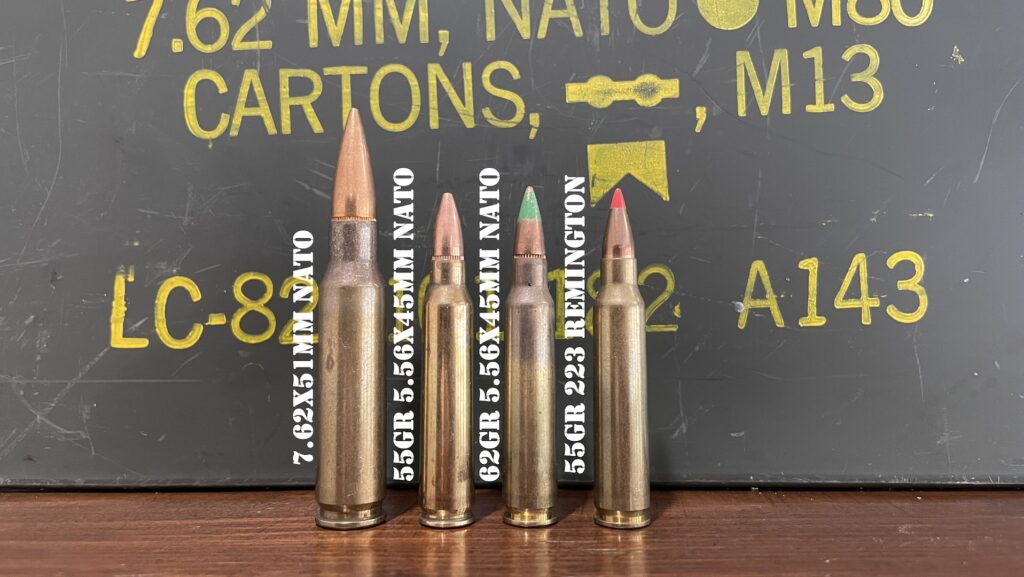
As good as the 223 Remington is though, hunters and shooters have long sought a more powerful cartridge that still functions well in the AR-15 platform.
That’s easier said than done and various cartridges have attempted to fill this niche over the years without much success.
For instance, the designers at Nosler and Federal both swung and missed with the 22 Nosler and the 224 Valkyrie for various reasons.
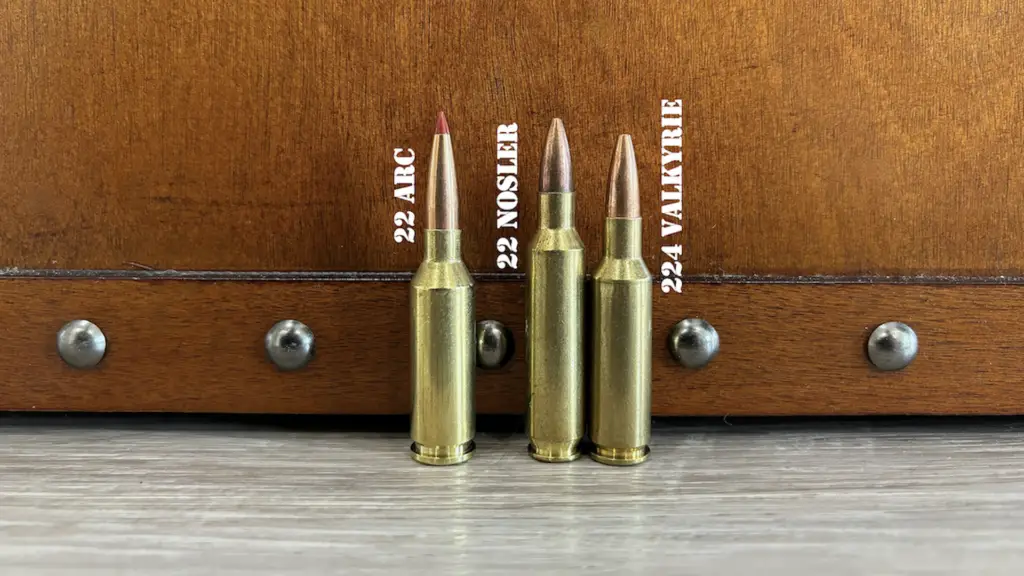
The folks at Hornady took a stab at this problem more recently.
As the story goes, some guys at Hornady started a side project they called the 22 Coyote about 10 years ago with a goal of delivering 22-250 level performance out of the AR-15.
The 22-250 Remington is a higher performance 22 caliber cartridge that can fling the same weight bullet 400-500fps faster than the 223 Remington. This is a dramatic improvement in performance and the 22-250 has a significantly flatter trajectory and quite a bit more muzzle energy than the 223.
The catch is the 22-250 is unfortunately too large to fit in an AR-15 and achieving that performance in the AR platform has long been a “holy grail” ballisticians have sought.
Why is that so important to some people?
A semi-automatic rifle like the AR-15 facilitates rapid follow-up shots. This is especially important if multiple dogs respond at once and it’s easier to score a double or a triple with a semi-auto than with a bolt-action.
Likewise, it’s also nice to have a second or even third shot on hand with minimal delay if the hunter fails to connect on their first try (or if the hunter wounds the animal with the first shot).
It took over a decade for everything to finally come together with the 22 Coyote project and Hornady standardized the new round with SAAMI in early 2024 as the 22 Advanced Rifle Cartridge.
Hornady claims “the 22 ARC brings extraordinary performance, that rivals the 22-250, to the AR-15 platform.”
Just like you see with any new product, skeptics immediately began sounding off about the new cartridge.
Some claimed that all Hornady did was slap a new label on a 22 Grendel wildcat.
Others yawned at the published ballistics of the new 22 ARC: sure, firing a 62gr bullet at 3,300fps is nice, but that’s nowhere near 22-250 level performance.
Are those skeptics correct?
Yes and no.
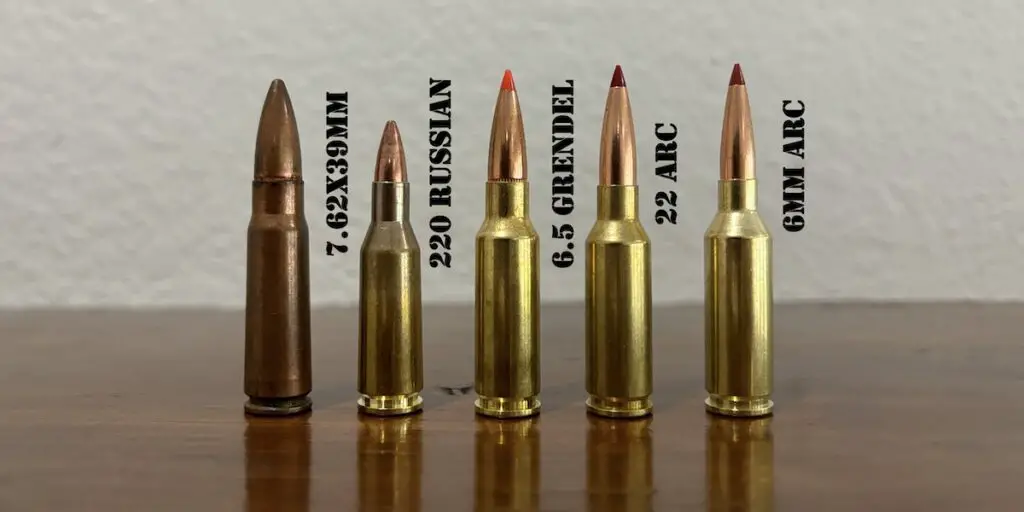
Just like its cousin the 6mm ARC, the 22 ARC is descended from the 6.5 Grendel (which is itself descended from the 7.62x39mm and 220 Russian cartridges). The 22 ARC is not simply a rebranded 22 Grendel wildcat as some have claimed though.
No, the 22 ARC also has several important modifications that make it more than just a 6.5 Grendel necked down to .22 caliber.
Furthermore, the ballistic performance of the 22 ARC is much more impressive than you might think at first glance.
I’ll cover the specifics of both issues shortly.
223 vs 22 ARC Cartridge Sizes
There are some pretty major differences in the physical dimensions of the .223 Remington and the 22 Advanced Rifle Cartridge.
First, though both fire the same .224″ (5.7mm) diameter bullets, there are some significant differences in bullet weights and bullet types suitable for each cartridge.
The 223 Remington has a SAAMI specified twist rate of 1:12″, but rifles chambered in 223 (or 5.56 NATO or 223 Wylde) often have faster 1:9″, 1:8″, and even 1:7″ rifling twist rates that can stabilize longer and heavier bullets.
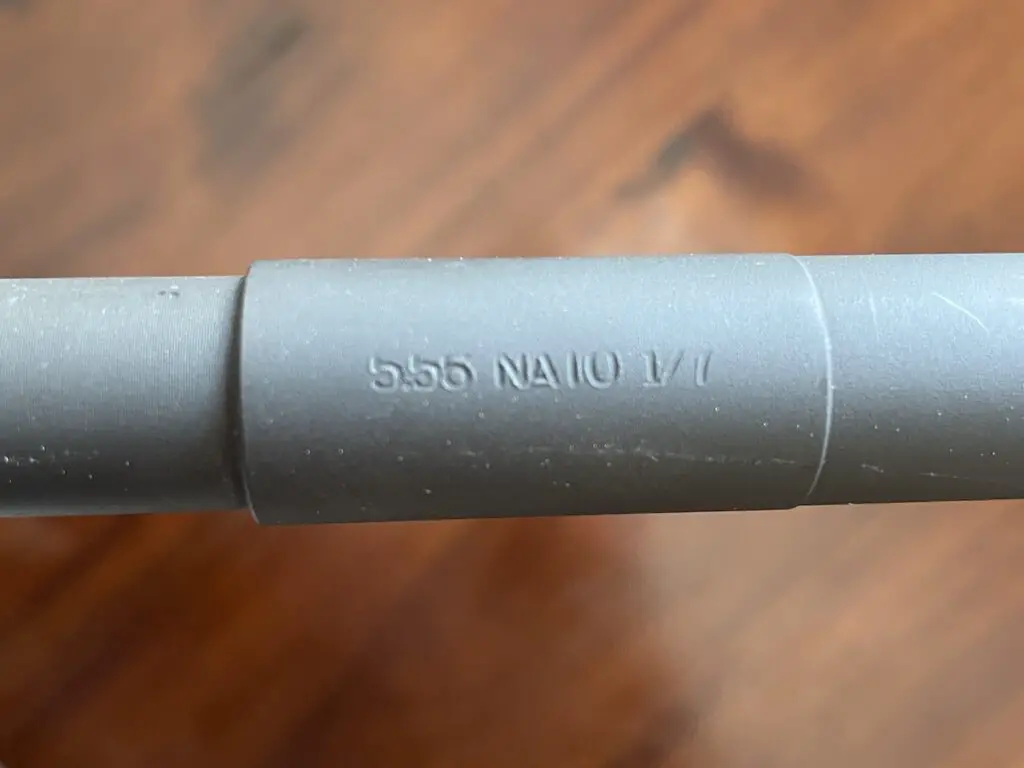
In fact, the faster twist rate of the 223 Remington enables that cartridge to use some longer, sleeker, and higher BC bullets other 22 caliber cartridges, like the 220 Swift and 22-250 Remington, can’t reliably stabilize with their slower SAAMI spec 1:14 twist rate.
Though handloaders can potentially utilize even heavier bullets, the vast majority of .223 Remington factory loads shoot bullets in the 35-80 grain range.
Of these, 53 grain, 55 grain, 62 grain are most common, though even heavier 75 and 77 grain bullet weights aren’t especially rare or difficult to find.
Various companies do offer even heavier and more aerodynamic bullets for the 223 Remington like the 75gr Hornady ELD Match (.467 BC), 77gr Sierra Tipped MatchKing (.420 BC), and Berger 90gr VLD Target (.534 BC).
Those bullets all require either a 1:8 or even a 1:7 minimum twist rate to stabilize (and some people use even faster twist rates with them). Additionally, those bullets (especially the 90gr VLD) are so large and take up so much powder capacity the 223 Remington can’t push them very fast: 2,600-2,800fps is about as fast as you can expect to shoot them.
The really long bullets also sometimes require a special chamber design and/or longer rifle magazine for optimal performance and function.
On the other hand, the 22 ARC was designed from the start to use really long, heavy, high BC bullets in the 62gr to 88gr range.
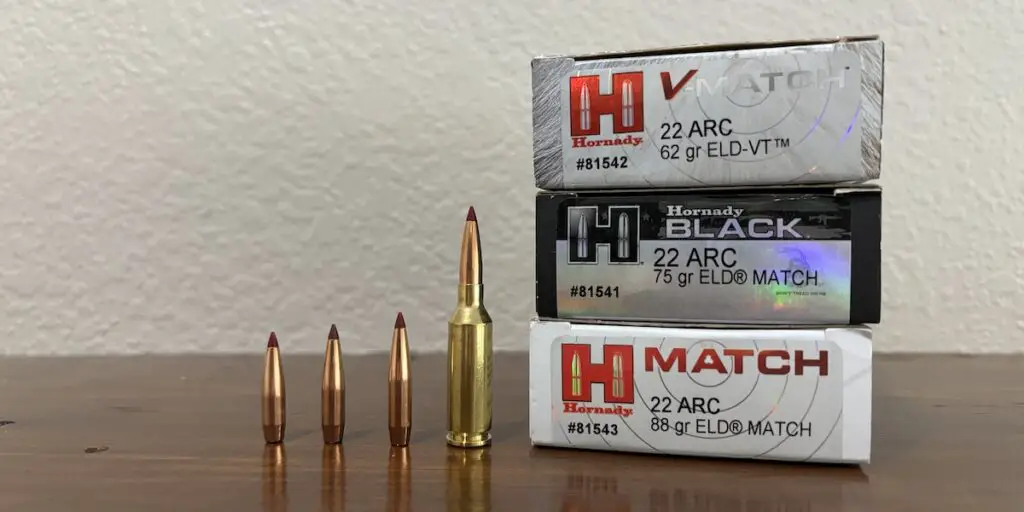
Specifically, it works especially well with the new 62gr ELD-VT bullet (.395 BC) along with the 75gr (.467 BC) and 88gr ELD Match (.545 BC) bullets.
This goes back to what I was saying earlier about how Hornady didn’t simply neck the 6.5 Grendel down to 22 caliber and load it with short, stumpy “legacy” varmint bullets like their 55gr V-Max. Though the 22 ARC can shoot lighter bullets, the folks at Hornady designed this cartridge for use with a brand new, high BC 22 caliber varmint bullet to further set the 22 ARC apart from the competition.
Specifically, they built a whole new line of ammo they’ve dubbed the V-Match line loaded with their new ELD-VT (Extremely Low Drag Varmint | Target) bullet. Just like the name states, V-Match ammo is optimized for match-grade accuracy and violent expansion upon impact with game.
Without going too deep into the weeds, the new ELD-VT bullet has an open cavity between the lead core and the polymer Heat Shield Tip.
This allows designers to use a very sleek overall projectile shape that still has a high BC, but is also lighter and can therefore be driven faster.
Second, this open cavity moves the center of gravity closer to the rear of the bullet and farther from the bullet’s center of pressure in an effort to improve stability and accuracy.
Finally, this cavity also helps deliver rapid, almost explosive expansion when it hits an animal.
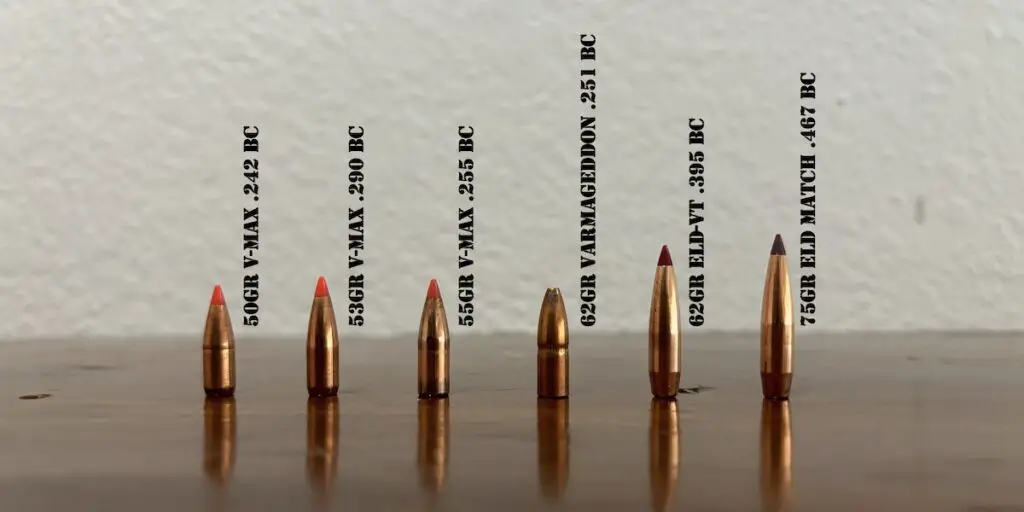
Not only can the 22 ARC fling that 62gr ELD-VT bullet really fast, but with a G1 BC of .395, it stands head and shoulders above typical varmint projectiles in the BC department. Plus, the 22 ARC can also fling those heavier bullets quite a bit faster than the smaller 223 (more on this in a minute).
How is this possible?
First, the 22 ARC has a SAAMI spec rifling twist rate of 1:7 to stabilize those long, high BC bullets.
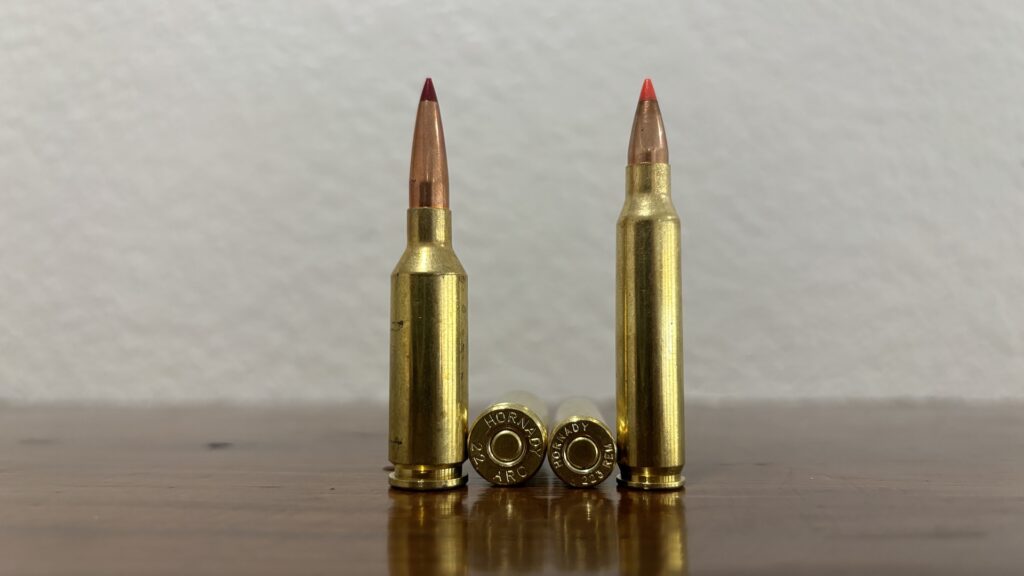
Next, it uses a fatter case than the 223 Remington and has a .441 case head diameter, which is quite a bit larger than the .223 Remington in that department (.3759″).
Both cartridges have the same maximum overall length of 2.26″, which is as long as a cartridge can be while still fitting in an AR-15.
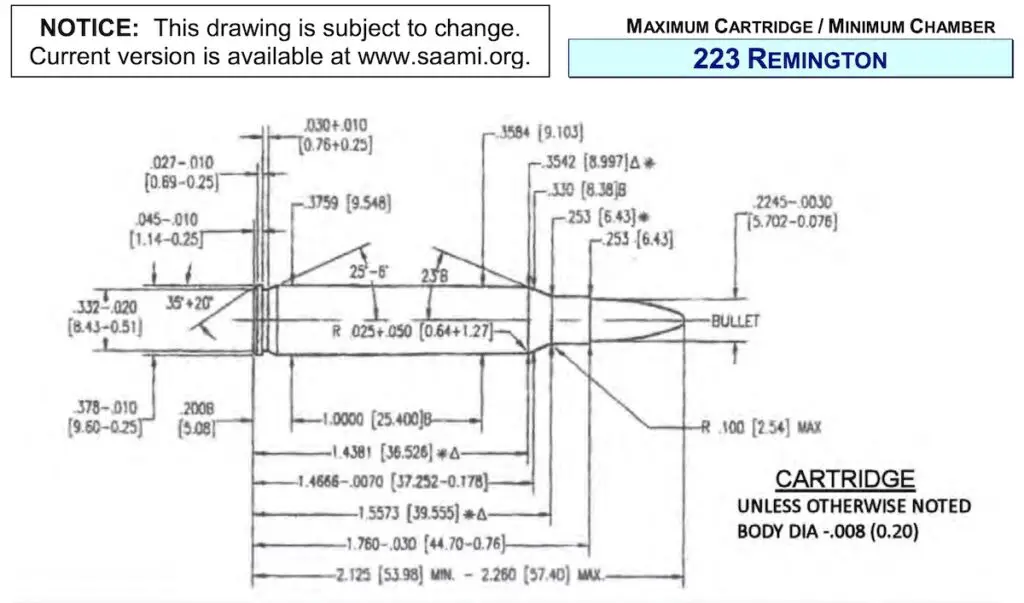
Additionally, the 22 ARC has a 30 degree shoulder angle while the 223 Remington has a 23 degree shoulder angle.
Though the 223 Remington has a slightly longer 1.76″ case length (compared to 1.525″ for the 22 ARC), the fatter 22 ARC still has about 10-15% more case capacity than the .223.
Even though the 22 ARC doesn’t appear to have a gigantic advantage over the 223 Remington in the case capacity department, the raw powder capacity of the cartridges doesn’t tell the whole story.
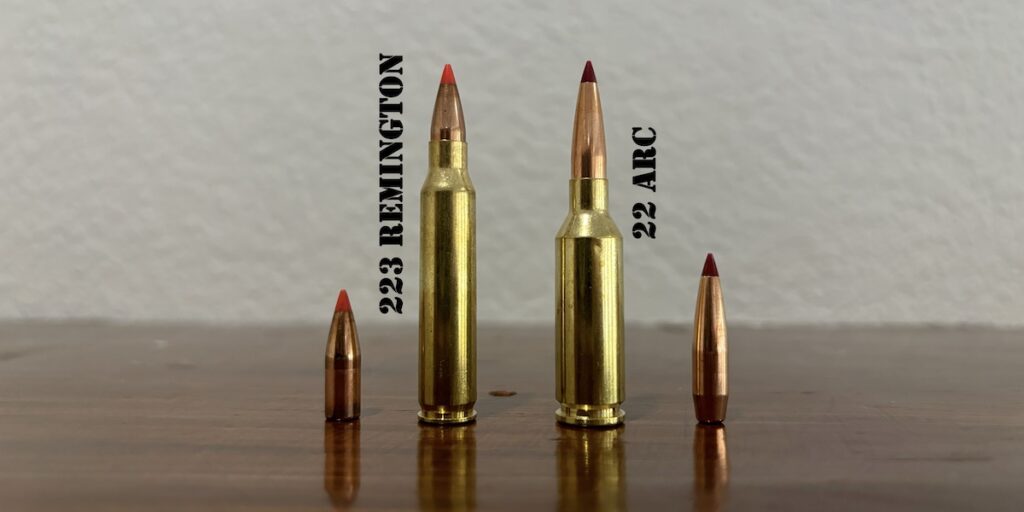
No, the 22 ARC has quite a bit more head height than the 223 Remington.
Head height is the amount of space available for the bullet outside the case while staying within SAAMI specifications for the cartridge. Put simply, more head height facilitates the use of very long, aerodynamic bullets without requiring them to be seated so deeply into the case they intrude into the powder column.
Since both cartridges have the same overall length of 2.26″, the 22 ARC actually has more head height (.735″vs .5″) than the 223 Remington since the newer cartridge has a shorter case.
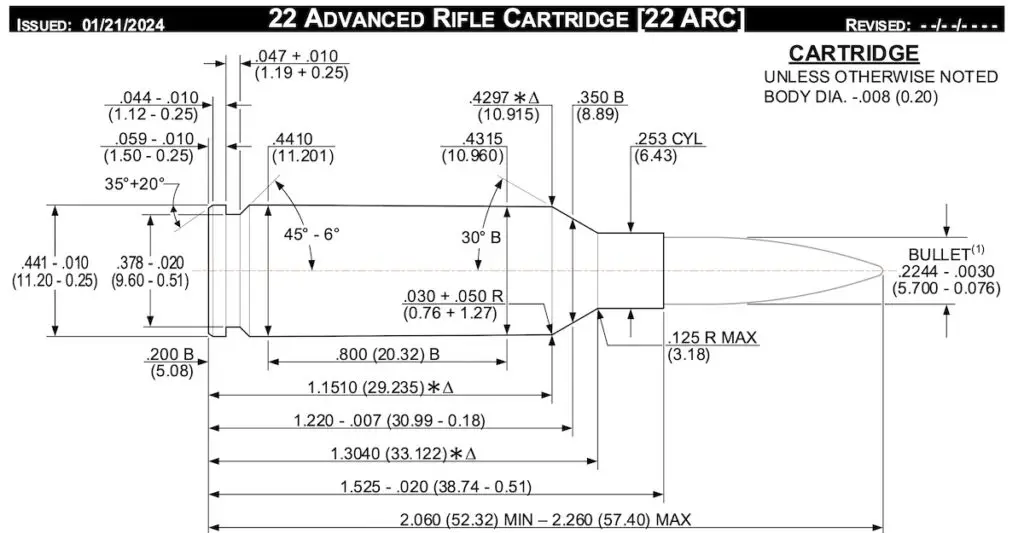
This means the 22 ARC actually has a bigger advantage over the 223 Remington when using heavier bullets than is the case with lighter bullets.
We’ll dig more into this in a minute.
Finally, the 223 Remington actually has a slightly higher SAAMI maximum average pressure of 55,000psi vs 52,000psi for the 22 ARC.
Though the 22 ARC has a SAAMI maximum average pressure of 52,000psi to make it compatible with the AR-15 (and factory ammo operates within those specs), Hornady has also published reloading data for bolt-action rifles that operates up to 62,000psi.
Note: while the powder capacity figures listed below do give a good indication of the differences between the two cartridges, exact case capacities vary slightly according to the brand of brass used.
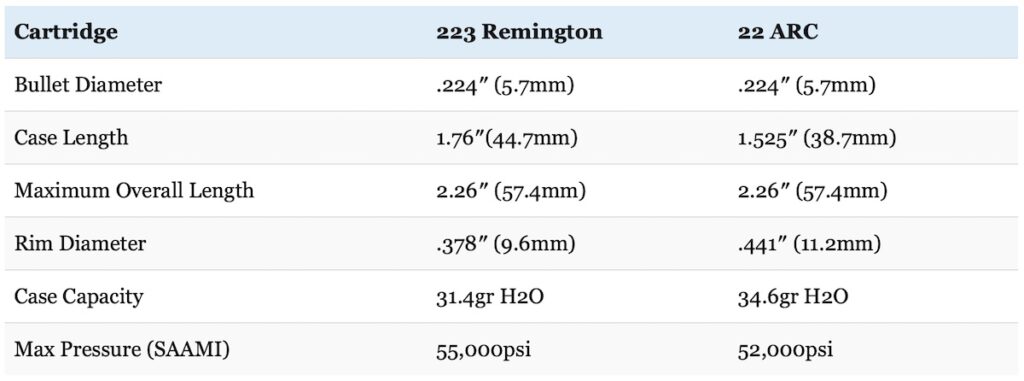
Note: while the case capacity listed above is a good indication of 223 Remington and 22 ARC powder capacity, exact case capacities will vary slightly according to the brand of brass used.
In this case, I obtained the 223 Remington figure from Chuck Hawks. I measured 22 ARC case capacity of 34.6gr H20 myself measuring the powder capacity of 5 individual 22 ARC expended cases (Hornady brass) and averaging their measured capacity.
22 ARC vs 223 Ballistics
So how does the 22 ARC stack up against the 223 in terms of ballistics?
To illustrate this, we’ll compare the 62gr and 75gr 22 ARC loads to a couple of popular varmint loads for the 223 Remington.
I’ll compare those 22 ARC loads to a run of the mill 55gr 223 Remington load from Hornady’s Varmint Express line (shooting a 55gr V-Max bullet with a .255 BC) and a high performance 223 Remington load from Hornady’s Superformance Varmint line (shooting a 53gr V-Max with a .290 BC).
The 53gr V-Max load is about as good as you’ll find for a high performance 223 Remington factory load: that bullet is as sleek as possible for a projectile that will work out of a barrel with the 223 Remington SAAMI spec twist rate of 1-12″. With a muzzle velocity of 3,465fps, it’s also going really fast.
I’ll also compare another 223 Remington load using a 75gr ELD Match bullet. Hornady doesn’t offer that bullet in a factory load for the 223, but they list a maximum velocity of 2,700 for it in their 10th Edition Reloading Handbook (p172).
Important to note that this bullet is really long and has a specified cartridge overall length of 2.39″ when loaded in the 223, which is too long to fit in typical 223 or 5.56 rifle magazines. This is why Hornady doesn’t offer it as a factory load.
You can make it work, but it takes some doing.
Like most companies, Hornady publishes their data for the 22 ARC and 223 Remington using a 24″ long barrel.
I have an Odin Works 22 ARC upper receiver with an 18″ long barrel that I’ve shot quite a bit over the past few months. Though I’ve never shot the 75gr ELD Match out of any of my 223 Remington rifles, I have shot the 53gr and 55gr V-Max bullets extensively out of my Diamondback DB-15 (which also has an 18″ barrel).
With this in mind, I’ll include ballistic data based both on advertised velocities as well as those actual velocities with both rifles shooting Hornady factory ammo for those two cartridges (all the loads I just mentioned except the 75gr 223 load) to give you an idea of what sort of performance you can expect from the 22 ARC under real world conditions with a shorter barrel.
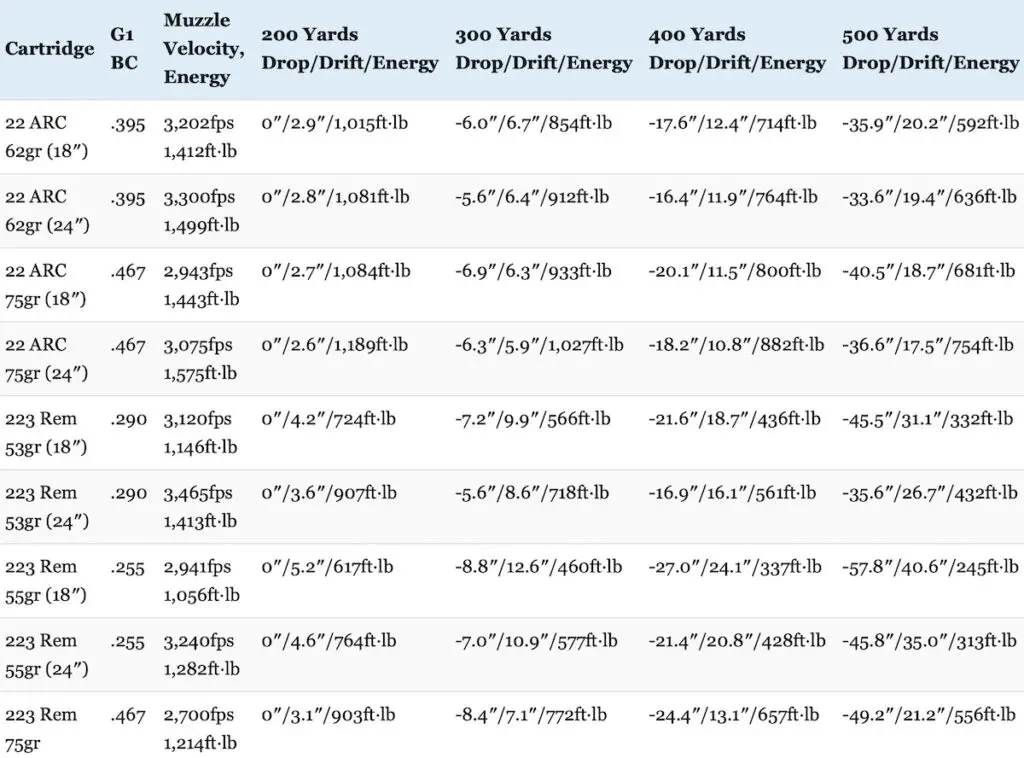
As you can see, the 62gr ELD-VT has a significant advantage over all the 223 loads, even when comparing the slowest 62gr load from an 18″ barrel to the fastest 223 load from a 24″ barrel.
Though the 2 loads have essentially the same muzzle energy and almost identical amounts of bullet drop downrange, the 22 ARC has about 19% more retained kinetic energy and nearly 2″ less wind deflection at 300 yards, and 37% more retained kinetic energy and about 6″ less wind deflection at 500 yards.
And remember: that’s based on real world velocity for the 22 ARC out of an 18″ long barrel compared to the advertised (and probably optimistic) performance for the 223 Remington out of a 24″ long barrel.
The difference is even more stark when you compare the 62gr ELD-VT to the slower and lower BC 55gr V-Max load.
Even assuming you’re getting the advertised velocity out of the 223 (and it was going nearly 300fps slower than advertised out of my rifle), and even assuming a loss of about 100fps vs advertised performance like I observed, the 22 ARC still has about 10% more muzzle energy, about an inch less bullet drop and just over 4″ less wind deflection at 300 yards, nearly 50% more retained kinetic energy at 300 yards, about 10″ less bullet drop and over a foot less wind deflection at 500 yards, and nearly 90% more retained energy at 500 yards!
While that 75gr 223 load hangs pretty well with the 62gr ELD-VT in the wind deflection and retained energy departments, the 22 ARC still beats it pretty handily in both areas when it’s shooting the 75gr bullet too.
Additionally, that 223 load easily has the most bullet drop out of everything in this comparison because it starts off going so slow due to the lower powder capacity of the 223 Remington.
As you can see, the 223 Remington (like all cartridges) also falls off in performance when you shoot it out of a shorter barrel and the advantages the 22 ARC has over it become even more apparent, especially in terms of wind deflection and retained kinetic energy.
This is especially true for wind deflection.
Assuming the same wind conditions, wind deflection is dependent on bullet velocity and BC. However, small changes in ballistic coefficient result in bigger changes in wind deflection than is the case with velocity.
The 22 ARC really shines in the wind, which is a key advantage when it comes to scoring hits on smaller targets at longer range.
A 2″ difference in the point of impact (which is about the advantage the slow 62gr ELD-VT has over the fast 53gr V-Max at just 200 yards) could easily be the difference between a hit and a miss on something small like a prairie dog, or between hit to the vitals that drops a coyote in its tracks vs a hit that’s not immediately lethal that allows the coyote to escape.
Not only do those factors make it easier to hit a target at long range, but the 22 ARC also simply hits harder, which can make a big difference in minimizing wounding loss and just quickly killing animals.
This was on display during a recent trip to the range where I shot my 22 ARC and 223 out to 500 yards.
It was a pretty windy day and I really had to work to hit those targets at 400 and 500 yards, even when using that high performance 53gr V-Max in my 223. In fact, I had to hold over a foot off the target into the wind just to barely hit the opposite edge of the steel plate at 500 yards with that 53gr V-Max.
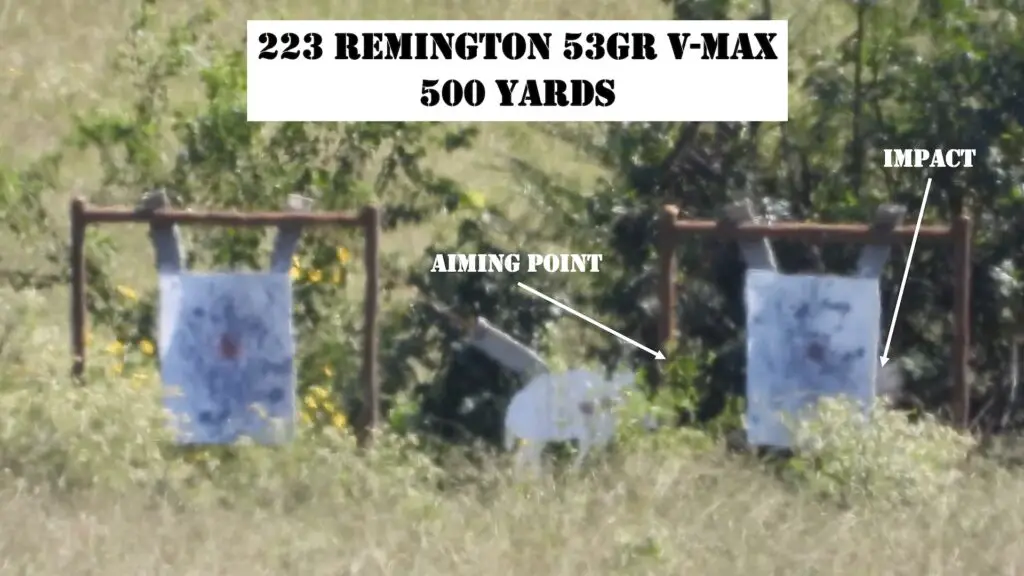
Even then, it was sometimes difficult to determine whether I hit the target because there was simply much less “splash” when the bullet impacted.
Things were much different with the 22 ARC: I needed to account for much less wind deflection to hit the target and my hits were obvious due to the significantly greater visual effects of the bullet impacting.
Shooting steel obviously is not the same as shooting an animal, but that additional retained energy downrange for the 22 ARC can result in a more devastating wound cavity that’s more likely to quickly kill an animal.
Furthermore, a handloader making a custom load for use in a bolt action rifle can further enhance the performance of the 22 Advanced Rifle Cartridge.
The 22 ARC has a SAAMI maximum average pressure of 52,000psi to make it compatible with the AR-15 (and factory ammo operates within those specs), but Hornady has published higher pressure load data for the cartridge for use in bolt-action rifles.
When loaded to 62,000psi and fired from a bolt action rifle with a 24″ long barrel, the 22 ARC is capable of pushing that same 62gr ELD-VT at velocities in excess of 3,500fps!
That blows even the high BC, high velocity 53gr V-Max load out of the water in the trajectory, kinetic energy, and especially wind deflection departments as the range increases.
And no, you can’t load the 62gr ELD-VT in a typical 223 rifle, even if it has a fast twist rate. Even though it weighs only 62 grains, the ELD-VT bullet is an especially long and sleek projectile and is thus too long to chamber in a 223 rifle with a normal magazine.
External ballistics don’t tell the whole story though and there’s more to picking a hunting cartridge than kinetic energy, bullet drop, or wind drift at various ranges.
For instance, now let’s talk about recoil.
The table below compares the recoil produced by the 55gr and 75gr loads for the 223 Remington vs the 62gr and 75gr loads for the 22 ARC when fired from identical rifles.
I used handload data from the Hornady reloading manual to get the powder charge info for the 75gr 223 load. I pulled bullets and weighted the powder charges from factory ammo I have on hand for the other three loads.
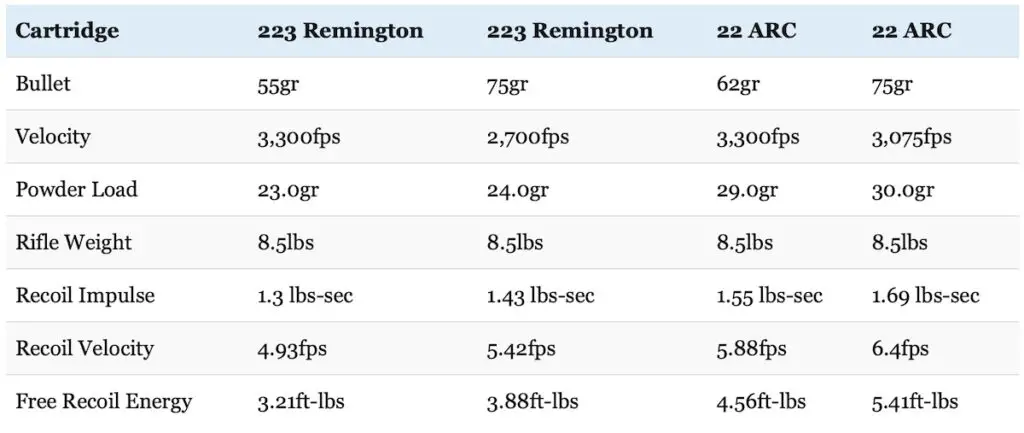
Felt recoil will vary from shooter to shooter and rifle to rifle, but free recoil energy is still a useful way to compare cartridges.
Neither cartridges recoils very much, but the 22 ARC has more recoil than the 223 Remington in this particular case.
Specifically, the 22 ARC has about 18-68% more free recoil energy than the 223 Remington here.
Sure, the 22 ARC recoils more, but to be perfectly honest, both cartridges have an exceptionally mild recoil and virtually any person, regardless of size or age, should be able to handle them with ease.
22 ARC vs 223 Accuracy
What about 22 ARC vs 223 accuracy?
Ballistic performance on paper (though not unimportant) doesn’t mean a darn thing if you can’t hit your target.
John Snow wrote a fantastic article on this subject for Outdoor Life that I suggest reading for more details.
Long story short, companies designing new cartridges these days typically employ cartridge design principles that incorporate best practices obtained from competition and benchrest shooters to obtain the best possible accuracy.
Cartridges designed using these principles use faster twist rates to stabilize heavy, high ballistic coefficient bullets, have cases with a long enough neck to support those longer, high BC bullets, can seat those long, high BC bullets to the SAAMI specified maximum overall length without intruding into the powder column, employ minimal body taper, and headspace off sharp shoulders.
Taken together, these design principles result in cartridges with a very high degree of accuracy potential, especially at long range.
Like I mentioned earlier, the 22 ARC design incorporates all of those principles.
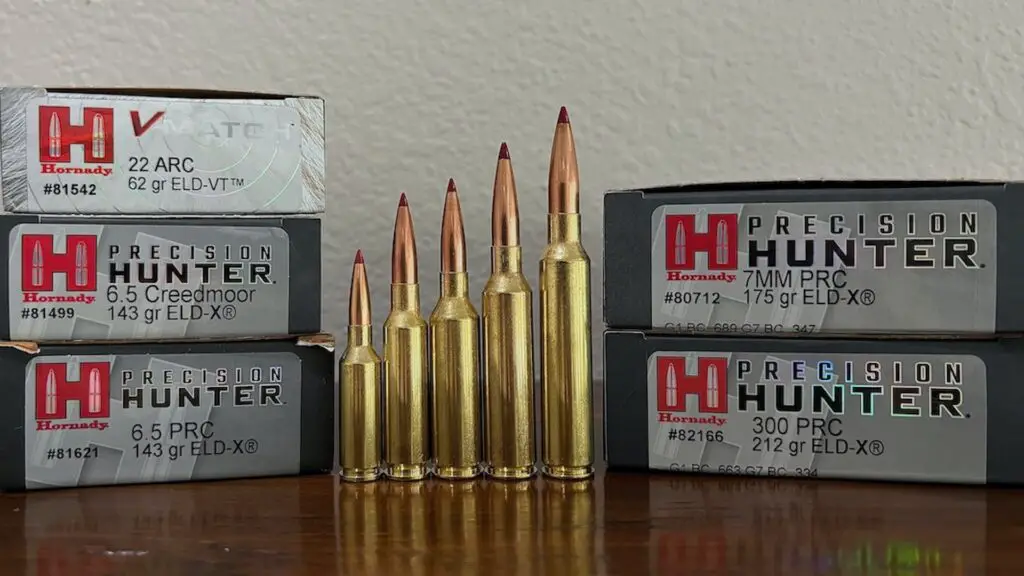
First, the 22 ARC has chamber geometry along the lines of Hornady’s successful (and highly regarded for accuracy) 6 mm ARC, 6.5 Creedmoor, and Precision Rifle Cartridge lines.
Additionally, the 22 ARC utilizes a steeper 30 degree shoulder for headspacing, has a fast 1:7″ SAAMI spec rifling twist, and has a long enough case neck and has ample head height to use those long, heavy, high-BC bullets I keep talking about.
Taken together, all of these factors result in excellent accuracy potential for the 22 ARC with factory ammo and off the shelf rifles, especially with long, heavy, high BC bullets.
Which one is better?
Both the 223 Remington and 22 ARC are certainly capable of excellent accuracy, but I have to give the advantage to the 22 ARC here.
Details will vary on the exact ammunition, rifle and shooter in question though and yes, there will be occasional instances of 223 rifles shooting better than 22 ARC rifles.
And yes, users can work around many of these problems to a certain degree with custom 223 Remington rifles, magazines, and handloads designed to accommodate higher BC bullets and fire them with a high degree of accuracy.
Or they can skip all that hassle and just get a factory 22 ARC rifle, which I think probably has some of the best potential for accuracy available today using factory rifles and ammunition out of all widely available 22 caliber centerfires.
So where do we stand overall?
22 ARC vs 223
The 22 ARC fires a heavier bullet with a higher BC much faster than the 223 Remington can fire a bullet of the same weight. For this reason, the 22 ARC has more recoil, but also has a flatter trajectory, more retained kinetic energy, and better resistance to wind deflection.
223 vs 22 ARC Ammo
This one is easy: the 223 Remington is by far the most popular of the two. In fact, the 223 Remington is currently the #1 best selling rifle cartridge in North America (especially when you roll 5.56 NATO ammo into the mix as well).
Basically every ammunition manufacturer of note like Armscor, American Eagle, Barnes, Black Hills, Browning, Federal, Fiocchi, Hornady, HSM, Nosler, Remington, Sierra, and Winchester (among others) produce a wide variety of ammo for the .223 Remington.
Most of those loads utilize either FMJ or Varmint bullets optimal for use at the range or for use on varmints, but there are a few other 223 Remington loads better suited for hunting big game.
For instance, Barnes offers factory loads for the 223 with 55gr, 62gr, and 70gr TSX bullets, Federal offers 62gr Fusion and 64gr Power Shok soft point loads, Nosler has a load with the 70gr AccuBond, there are loads from a couple different companies with a 77gr Tipped MatchKing from Sierra, and Winchester also loads 223 ammo with their 64gr Power Point and Extreme Point bullets.
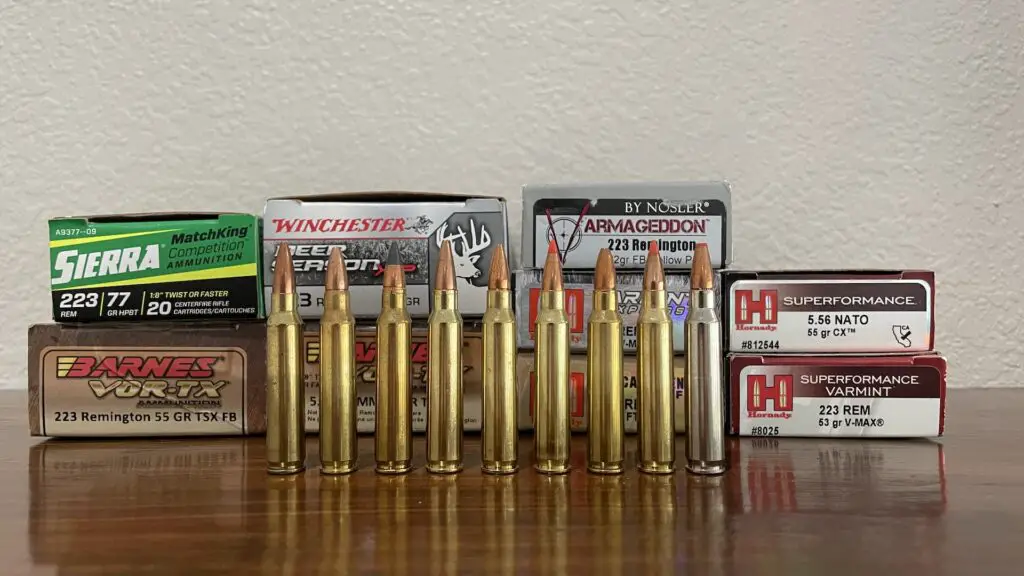
At this instant, Hornady is the only company that manufactures factory 22 ARC ammo.
They currently offer three factory loads for the cartridge: an offering in their V-Match line using a 62 grain ELD-VT bullet, an offering in their Black line using a 75 grain ELD Match bullet, and an offering in their Match line using an 88-grain ELD Match bullet.
Though some like to hunt big game with it, Hornady does not market the ELD Match bullet for hunters, so the 75gr and 88gr offerings are probably best used at the range.
On the other hand, the V Match 22 ARC load is designed and marketed for varmint hunting. That 62gr ELD-VT bullet is very soft and is specifically designed for rapid expansion on animals like coyotes and prairie dogs.
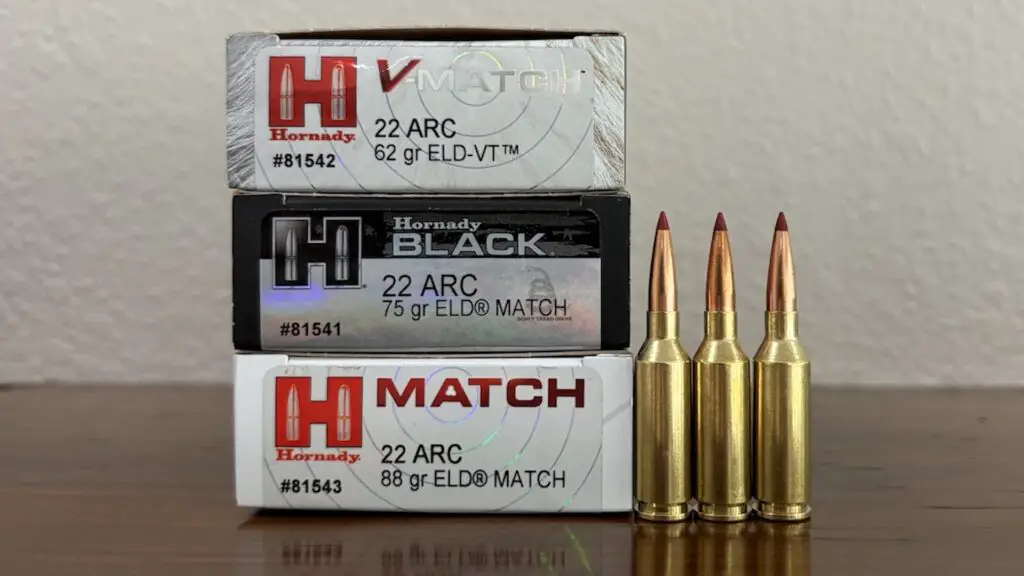
Though one could make the argument the 22 ARC has a better selection of ammo for some very specific situations than the 223 Remington, the 223 Remington beats the 22 ARC hands down in terms of raw ammo availability and variety at this instant.
I don’t see that changing in the near future either.
Furthermore, the 223 Remington has a big advantage in terms of the cost of ammo too. This applies to hunting ammo, high end target shooting ammo, and especially in terms of inexpensive “plinking” ammunition (of which none exists for the 22 ARC right now).
If you’d like to learn more about some of the various hunting ammunition choices for the 223 Remington cartridge, read the article below:
Best 223 Remington Ammo For Hunting Deer, Hogs, & Other Game
223 vs 22 ARC Rifles
Once again, the 223 Remington easily beats the 22 ARC in terms of rifle availability.
To start off, both are available in semi-automatic platforms.
While very few AR-15s are actually chambered in 223 Remington, there’s a massive selection of ARs in either 5.56 NATO or 223 Wylde (both of which can safely and reliably shoot 223 and 5.56 ammo)
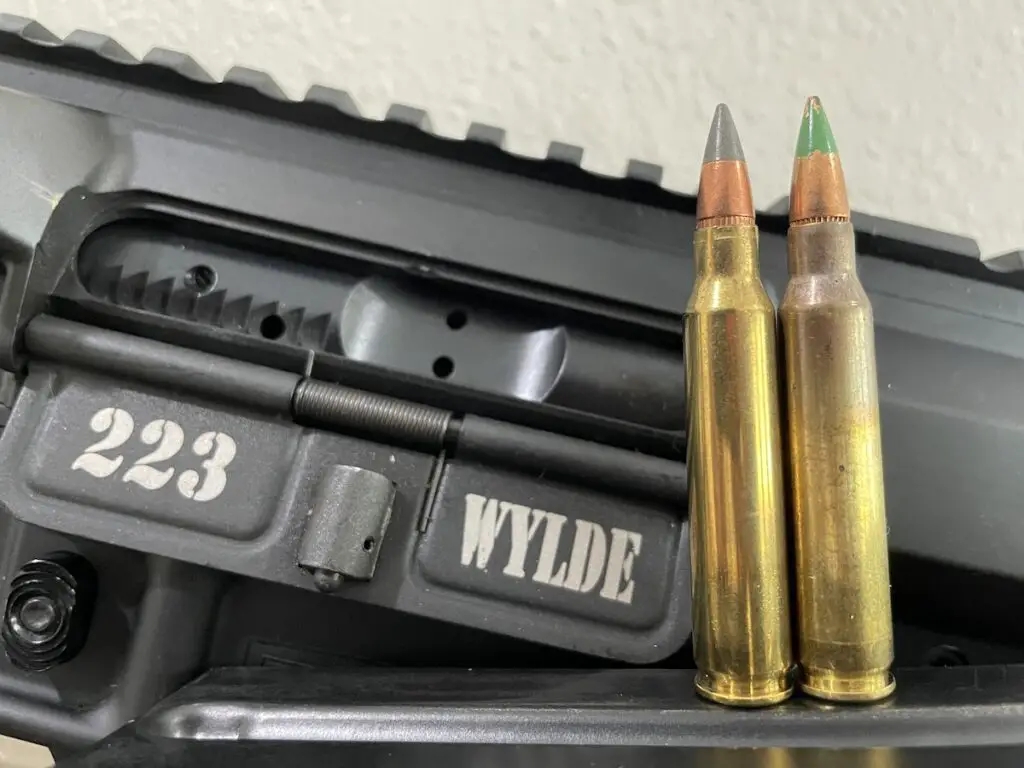
This “family” of closely related cartridges is easily the most popular chambering for AR-15 style rifles in the world. In fact, if somebody tells you they have an AR, odds are it’s either a 223 Wylde or 5.56 NATO unless they specifically say otherwise.
How many different companies produce ARs in those chamberings? To quote Elizabeth Barrett Browning: “Let me count the ways.”
Just to scratch the surface we have Aero Precision, Bushmaster, CMMG, Daniel Defense, Diamondback, DPMS, H&K, Mossberg, Noveske, Odin Works, Palmetto State Armory, Ruger, Savage, Sig Sauer, Smith & Wesson, and Wilson Combat.
The cartridge is also available in other semi-automatic rifles that are not technically AR-15s, like the piston driven Sig Sauer MCX and H&K 416 as well as the Ruger Mini-Fourteen.
Additionally, the 223 Remington is also pretty common in bolt-action hunting rifles like the Browning X-Bolt, CVA Cascade, Howa 1500, Mossberg Patriot, Remington 700, Ruger American, Ruger American Ranch, Ruger Hawkeye, Savage Axis, Savage 110, Tikka T3x, Winchester XPR, and Weatherby Vanguard.
You can even get lever action rifles chambered in 223 Remington like the Browning Lever Action Rifle (BLR) and the Henry Long Ranger.
Now let’s switch gears and talk about 22 ARC rifles.
Hornady usually does a great job of getting rifle manufacturers to pick up their new cartridges when they release them.
Well, even though the cartridge is less than a year old as I type this, a bunch of companies already produce a mix of semi-automatic and bolt-action 22 ARC rifles like Aero Precision, Christensen Arms, CMMG, Faxon, GA Precision, Howa, HS Precision, Kelby’s, ODIN Works, Proof Research, Ruger, and Seekins Precision.
Though there’s not quite as wide of a selection of 22 ARC rifles right now as there is for the 223 Remington, there’s still a good mix of rifles available at various price points.
For instance, Ruger offers the 22 ARC in their Ruger American Rifle Generation II line in Standard, Predator, and Ranch configurations with 16.1″, 20″, and 22″ barrel lengths.
Those are excellent options for a lower priced bolt-action 22 ARC rifle.

The bolt-action Proof Research Elevation MTR 2.0, which retails for over $3,000, is on the other end of the price spectrum for 22 ARC rifles.
That’s all well and good with those bolt-action 22 ARC rifles, but Hornady designed the 22 ARC to wring some additional performance out of the AR-15 platform and there’s also a good selection of semi-automatic rifles in that chambering too.
You can either purchase a complete 22 ARC AR-15, or just buy a 22 ARC upper receiver from several different companies to mate with a lower receiver you already own.
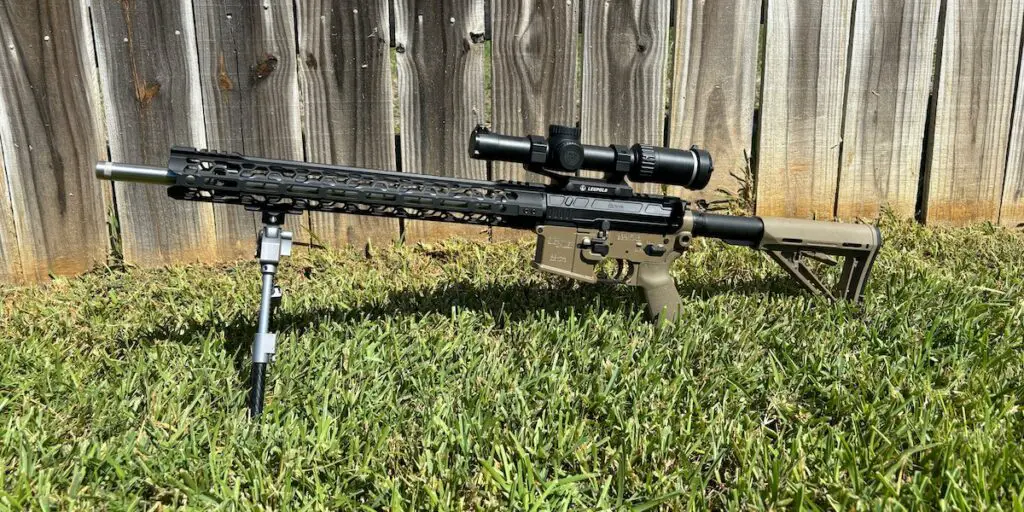
For instance, I have a 22 ARC complete upper receiver from ODIN Works. They offer 22 ARC uppers with either 16.1″, 18″, or 21″ long barrels (mine is 18″). They are designed for use with a suppressor and all come threaded (1/2-28 TPI), with adjustable gas systems, and with the ODIN XCH eXtended Charging Handle.
The folks at ODIN Works take a lot of pride in the accuracy of their rifles and that’s what I’ve experienced with mine, which shoots all three Hornady 22 ARC factory loads really accurately.
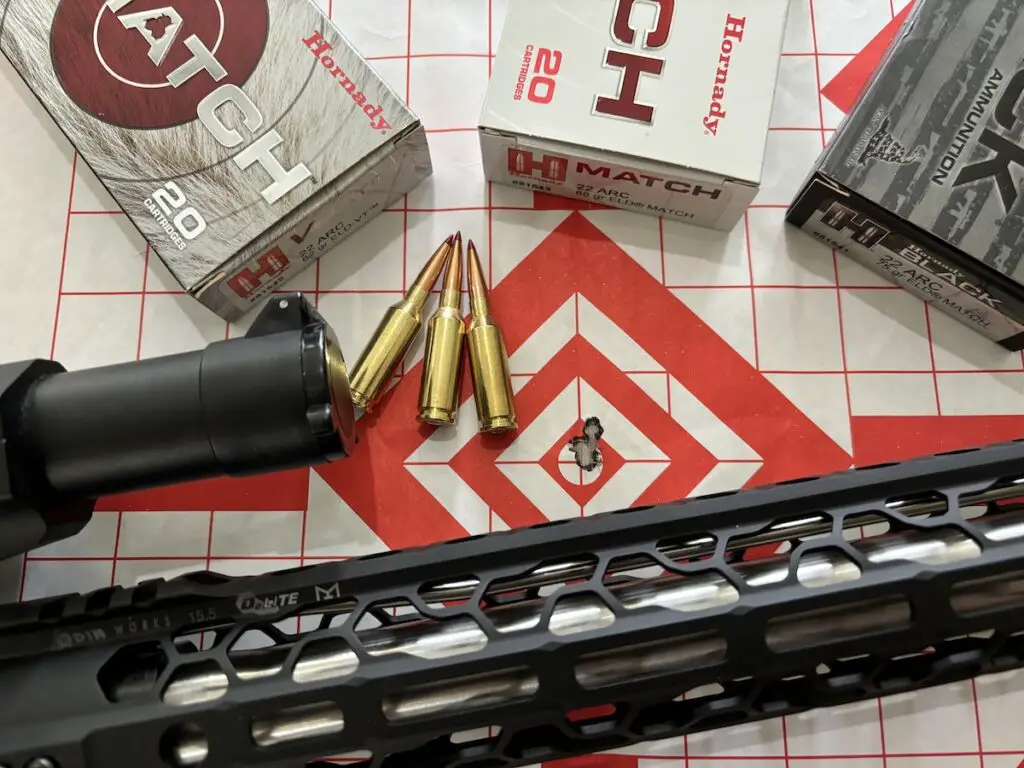
They’re far from the only company that makes an AR-15 in 22 ARC though. For instance, you can get one from Faxon, Rise Armament, and CMMG or build your own with components from a company like Aero Precision.
Remember what I mentioned earlier about twist rates for these cartridges?
223 Remington rifles are available with a wide variety of twist rates.
For instance, the 223 Remington versions of the BLR, and older bolt-action rifles, often use a 1:12″ twist rate in accordance with SAAMI specs. However, a faster 1:8″ twist rate is pretty common otherwise with current production bolt action rifles like the Winchester XPR, Ruger American, and Browning X-Bolt.
The Ruger Mini-14 uses a 1:9 twist rate and most ARs use a 1:7 or 1:8 twist rate (both of mine have a 1:7 twist rate).
On the other hand, 22 ARC rifles are almost exclusively produced with a 1:7 twist rate.
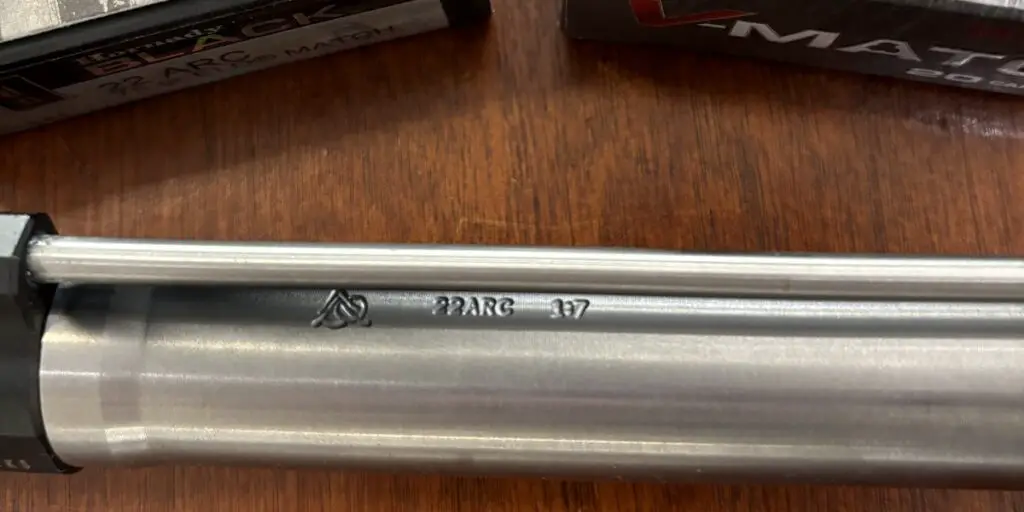
Additionally, we need to talk about barrel lengths.
223 Remington rifles will often have a broad range of barrel lengths ranging from 16″ up to 24″ long in some cases.
16″, 18″, and sometimes 20″ barrels tend to be pretty common with semi-autos. Bolt-action rifles will generally run in the 20-24″ range (but you can sometimes find shorter barrels on bolt guns and longer barrels on semi-autos).
At this point, the 22 ARC is most common with 16″, 18″, and 20″ long barrels, though there’s that one variant of the Ruger American with a 22″ long barrel.
223 vs 22 ARC: Which Is Right For You?
Are you looking for a good all around varmint or predator hunting cartridge? Both the 223 Remington and 22 ARC are excellent cartridges for hunting animals like coyotes and prairie dogs.
The 22 ARC has a flatter trajectory, performs better in windy conditions, and carries significantly more energy out to extended range, so it has a definite advantage at longer range. I think it’s also a better choice for use on bigger varmints like coyotes.
In fact, I think the 22 ARC is almost the perfect cartridge for coyote hunting. This is especially true for hunters pursuing coyotes at night with a thermal sight and/or in windy conditions.
Obtaining an accurate range is very difficult at night, but the flat shooting and wind bucking characteristics of the round that are significantly better than the 223 really come in handy under those conditions. Plus, the fact that it’s a low recoil cartridge designed for use in an AR-15 (instead of being primarily restricted to a bolt action like a 22-250) also facilitates rapid follow-up shots.
Those characteristics make it easier to place shots more accurately on coyotes, but the 22 ARC is also more likely to anchor a coyote with even a less than perfect shot since it just hits with more authority and uses that devastating ELD-VT bullet.
It works great at shorter range, but the 22 Advanced Rifle Cartridges really comes into its own in open country where longer shots are a possibility and a solid hit (and possibly even a less than perfect hit) with a 22 ARC will often put a coyote down for good.
I’ve shot the 55gr V-Max and 62gr ELD-VT bullets from the 223 and 22 ARC into ballistic gel.
The 62gr ELD VT produced a wider and longer wound track that can potentially pay some dividends with less than ideal shot placement. The same is also true for a shot on an animal running directly away from the shooter.
While a hit from a 55gr V-Max from a 223 will still likely cripple the animal if it doesn’t kill it outright with that shot angle, the deeper overall penetration and longer wound cavity of the 62gr ELD-VT is more likely to cause devastating damage to the vitals of that animal and thus kill it faster.
On the downside, I can certainly see the 22 ARC as being rougher on fur than the 223. If your goal is to quickly kill a predator or varmint and minimize wounding loss (like during a coyote hunting contest), then this is the round for you.
I personally would be hesitant to use the 22 ARC if I were trying to sell the furs of those animals afterwards.
None of this is to say the 223 Remington isn’t capable of cleanly killing coyotes. On the contrary, it can be extremely effective in that role and, with the right ammunition and rifle set-up (like a bolt action rifle with a 24″ barrel shooting spicy handloads or Hornady Superformance ammo with a 53gr V-Max) still does pretty well at extended range.
The downside of going that route is you must use a bolt-action rifle to squeeze out that extra performance instead of a semi-auto like you can with the 22 ARC.
But what if you’re hunting under conditions where you’re unlikely to take a longer shot?
Good question.
Though the 22 ARC is still more powerful, the 223 is a pretty flat shooting cartridge itself and doesn’t require much holdover or wind hold inside 300 yards. If you’re hunting in thicker country and shots farther than that are uncommon, then the 223 isn’t really giving up much to the 22 ARC.
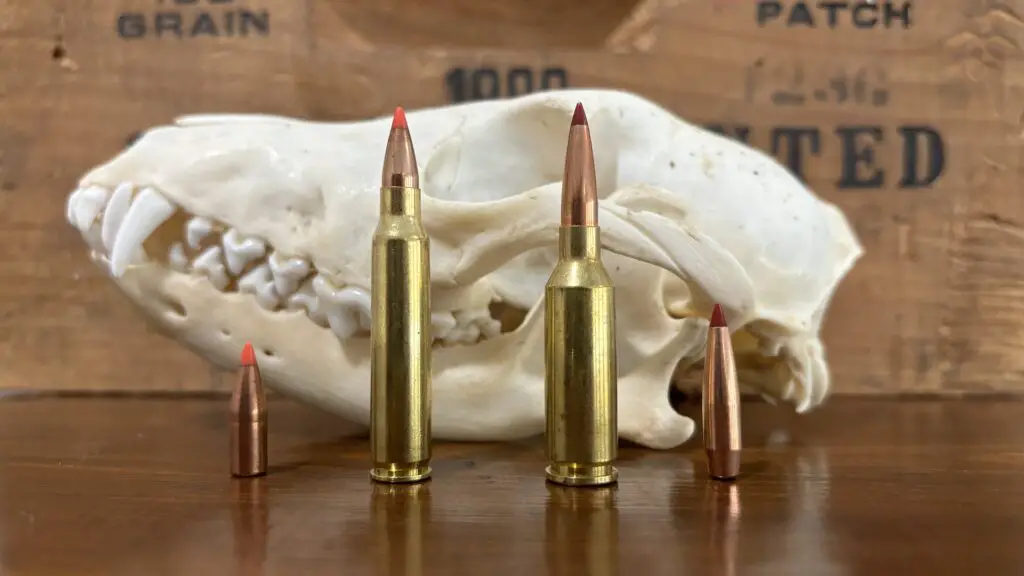
Sure, the 22 ARC is still more powerful, but does it make much difference whether you shoot a coyote at 85 yards with a good varmint bullet that has 850ft-lbs or 1,200ft-lbs of retained kinetic energy?
I doubt it. That’s probably a dead dog either way.
Don’t forget the massive advantages the 223 Remington has in terms of ammo and rifle availability, reliability, and cost either. As the saying goes, “amateurs study tactics and professionals study logistics.”
The 223 Remington blows the 22 ARC out of the water in this area while still being “good enough” for use in many coyote hunting situations.
Do you want a cartridge ideal for hunting big game like feral hogs and deer? First, beware that .22 caliber cartridges are not legal for big game hunting everywhere.
Assuming they are legal to hunt big game where you live, the 223 Remington is by far the best choice out of these two cartridges for hunting big game because there’s a much bigger supply of .223 Remington factory ammo suitable for big game hunting (like the Barnes VOR-TX, the Hornady CX, and the Nosler AccuBond, E-Tip, and Partition) than the 22 ARC.
That being said, the 22 ARC can also work in this role too, but you’ll need to handload for it.
The V Match 22 ARC load is wonderful for use on stuff like coyotes, prairie dogs, foxes, and bobcats, but I do not advise using that bullet on big game. In fact, I’ve heard stories of terrible penetration from coyote hunters who encountered a hog by happenstance and shot it with the 62gr ELD-VT they had in the chamber.
Likewise, Hornady does not advise using either ELD Match bullet on big game.
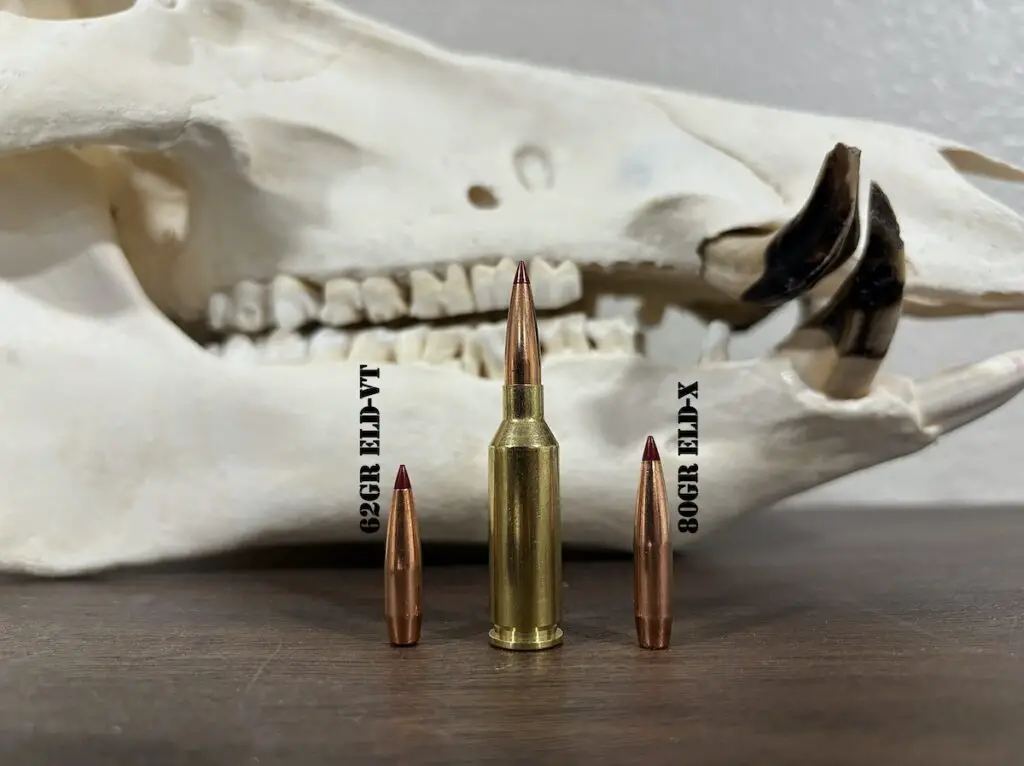
You can make 22 ARC handloads using the 80gr Hornady ELD-X bullet also used in the 22 Creedmoor though. Hornady publishes online load data for the cartridge using that bullet in both a bolt action rifle and in a gas gun. You can make a pretty spicy load using the ELD-X that should be surprisingly effective on deer sized game.
In my humble opinion, there is a screaming need for some factory loads using that 80gr ELD-X along with something along the lines of a really tough, 70gr CX lead free bullet.
I personally wouldn’t recommend using either cartridge on game bigger than deer though.
Are you looking for a cartridge with lots of inexpensive ammo for target shooting or just fun “general “plinking” at the range? The .223 Remington has a massive advantage in terms of sheer ammo availability and pricing.
This is definitely the better choice if you want to shoot beer cans in the field behind your house.
For serious precision shooting at long range, the 22 ARC is the way to go though. That 75gr ELD Match load is a wonderful all-around target shooting load and the 88gr ELD Match really comes into its own out past 700-800 yards for those who really want to shoot at long range with it.
Are you very sensitive to recoil? Both are pretty light recoiling, but the .223 Remington definitely has less recoil than the 22 ARC.
Do you want a cartridge suitable for a SHTF scenario, home defense, or a tactical situation? The choice is easy here: the 223 Remington. This is because the cartridge is available in such a wide variety of rifles and there’s such a massive supply of ammunition designed specifically for the task
Though the differences between them (22 ARC vs 223) are fairly significant in some respects, both are highly capable predator and varmint cartridges. There’s a fair amount of overlap in their best use cases, but each is also best suited for unique conditions.
For this reason, you should carefully analyze your potential needs before making a decision. In the end, a lot of this decision comes down to personal preference, the exact game you’re after, and the conditions of your hunt. So, choose the one that you feel most comfortable with and it will probably serve you well afield. Good luck!
NEXT: BEST 6.5 CREEDMOOR AMMO FOR HUNTING ELK, DEER, & OTHER BIG GAME
NEXT: BEST GIFTS FOR HUNTERS
Enjoy this article comparing the 223 Remington and 22 Advanced Rifle cartridges? Please share it with your friends on Facebook and Twitter.
The Lyman 50th Edition (p139-143), Hornady 10th Edition (p160-178), and Speer Number 10 (p120-123) reloading manuals were used as references for the history of the cartridges. The data used to compare the trajectory and wind drift of the cartridges was obtained from Hornady (here, here, here, and here). Case capacity information for the 22 ARC vs 223 were obtained from Chuck Hawks. I used Shooters Calculator to compare trajectories, wind drift, and recoil for the cartridges. Maximum pressure and cartridge dimensions obtained from SAAMI (here and here on p26 and p68).
Make sure you subscribe to The Big Game Hunting Podcast and follow The Big Game Hunting Blog on Facebook, Instagram, Twitter, and YouTube.
John McAdams is a proficient blogger, experienced shooter, and long time hunter who has pursued big game in 8 different countries on 3 separate continents. John graduated from the United States Military Academy at West Point and is a veteran of combat tours with the US Army in Iraq & Afghanistan. In addition to founding and writing for The Big Game Hunting Blog, John has written for outdoor publications like Bear Hunting Magazine, The Texas State Rifle Association newsletter, Texas Wildlife Magazine, & Wide Open Spaces. Learn more about John here, read some of John’s most popular articles, and be sure to subscribe to his show: the Big Game Hunting Podcast.

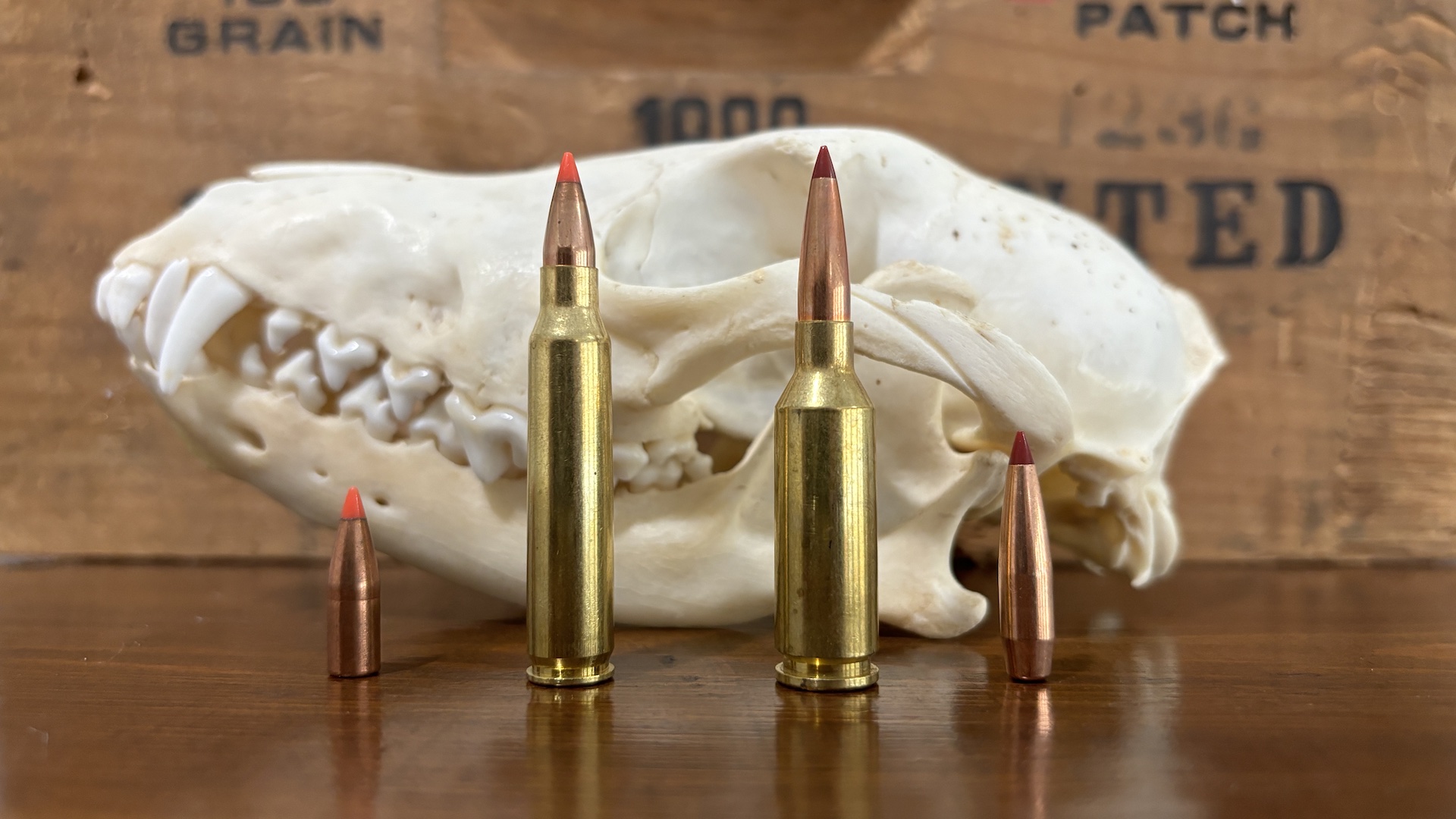

Irregardless of how you twist it, Hornady absolutely did just saami the necked down Grendel and call it their own. You need to be honest if you want to be respected. Don’t try to twist things for Hornady. They have been really good at taking credit for others work lately and people need to know that.
Really? I didn’t know somebody else had necked down the 6.5 Grendel, applied that specific chamber geometry Hornady likes to use, combined it with a fast 1:7 twist barrel, AND already made extremely high BC varmint and big game hunting bullets along the lines of the 62 gr ELD-VT and 80gr ELD-X to go with their 22 Grendel wildcat. Pretty incredible such a thing existed before the 22 ARC and Hornady was able to steal that whole package without anybody knowing about it.